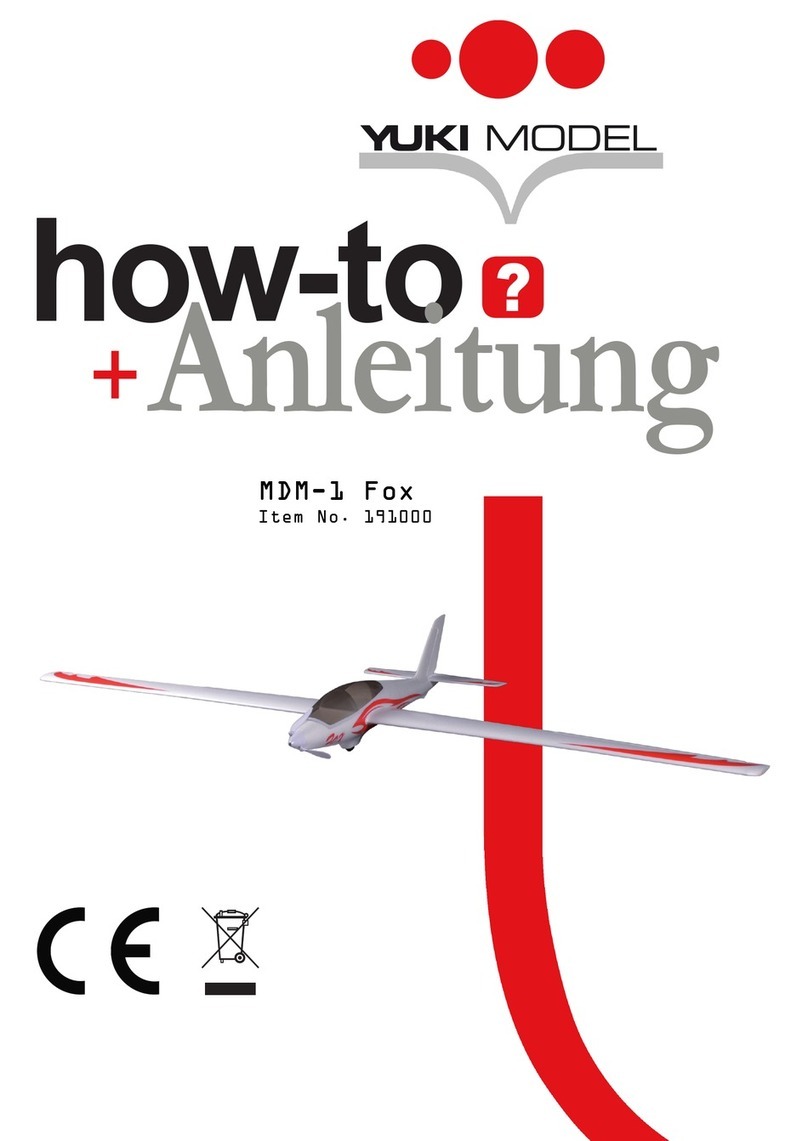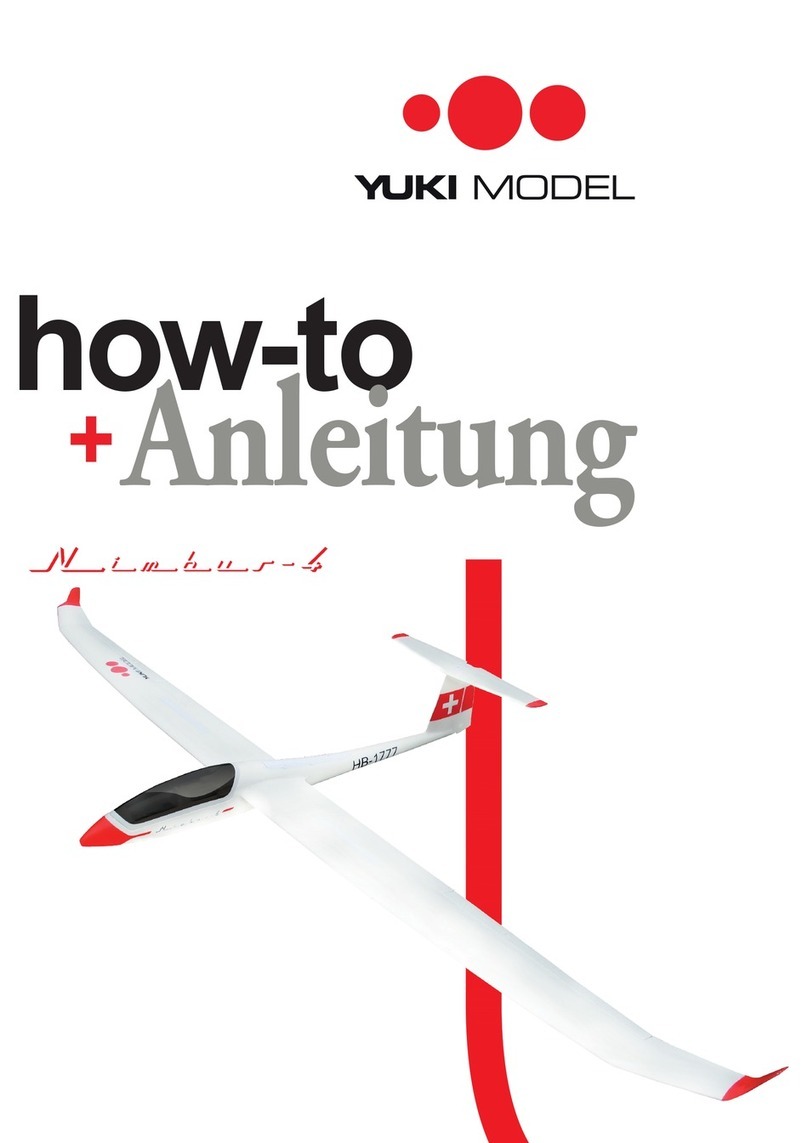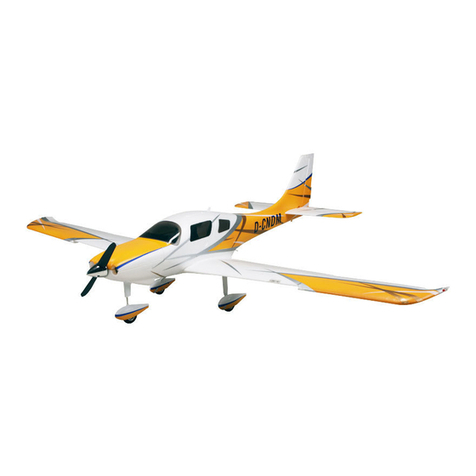
To avoid scratching your new aeroplane we suggest that you
cover your workbench with an old towel. Keep a couple of
jars or bowls handy to hold the small parts after you open the
bags.
Please trial t all parts. Make sure you have the correct parts
and that they t and are aligned properly before gluing! This
will ensure proper assembly as the EDGE 540 is made from
natural materials.
The paint and plastic parts used in this kit are fuel proof. Ho-
wever, they are not tolerant of many harsh chemicals inclu-
ding the following: paint thinner, cyano-acrylate glue accelera-
tor, cyanoacrylate glue de-bonder and acetone.
Um das verkratzen Ihres neuen Flugzeugs zu vermeiden, soll-
ten Sie Ihre Werkbank abdecken. Benutzen Sie Behälter um
Kleinteile aufzubewahren.
Achten Sie darauf, dass die richtigen Teile ordnungsgemäß
vor dem Kleben ausgerichtet sind! Dadurch wird eine fachge-
rechte Montage an der Edge 540 sichergestellt.
Die Lack und Kunststoffteile in diesem Kit wurden einen
Brennstofftest vollzogen. Sie sind jedoch nicht tolerant ge-
genüber vielen, aggressiven Chemikalien wie z.B: Verdünner,
Cyano- Acrylat-Klebstoff Beschleuniger, Sekundenkleber und
Aceton.
1) Carefully remove the aileron from one of the
wing panels. Note the position of the hinges.
2) Remove each hinge from the wing panel and aileron and
place a T-pin in the center of each hinge. Slide each hinge
into the wing panel until the T-pin is snug against the wing
panel. This will help ensure an equal amount of hinge is on
either side of the hinge line when the aileron is mounted to
the aileron.
3) Slide the wing panel on the aileron until there is only a slight
gap. The hinge is now centered on the wing panel and aileron.
Remove the T-pins and snug the aileron against the wing pa-
nel. A gap of 1/64” or less should be maintained between the
wing panel and aileron.
4) Deect the aileron and completely saturate each hinge with
thin C/A glue. The ailerons front surface should lightly contact
the wing during this procedure. Ideally, when the hinges are
glued in place, a 1/64” gap or less will be maintained throug-
hout the lengh of the aileron to the wing panel hinge line.
5) Turn the wing panel over and deect the aileron in the op-
posite direction from the opposite side. Apply thin C/A glue to
each hinge, making sure that the C/A penetrates into both the
aileron and wing panel.
6) Using C/A remover/debonder and a paper towel, remove
any excess C/A glue that may have accumulated on the wing
or in the aileron hinge area.
1) Entfernen Sie das Querruder vorsichtig aus einer der Trag-
ächen. Beachten Sie die Position der Scharniere.
2) Nehmen Sie jedes Gelenk von der Tragäche+Querruder
und setzen Sie ein T-Pin in der Mitte jedes Scharniers. Schie-
ben Sie jedes Scharnier in die Flügelplatte bis der T-Pin direkt
auf der Tragäche sitzt. Dies wird dazu beitragen, eine glei-
che Menge Scharniere beidseits der Gelenke zu haben.
3) Schieben Sie die Tragäche auf das Querruder, bis nur
noch ein kleiner Spalt vorhanden ist. Das Scharnier ist nun
auf der Tragäche und Querruder zentriert. Die T-Pins entfer-
nen und sachte das Querruder gegen die Tragäche drücken.
Eine Lücke von 1/64“ sollte zwischen der Tragäche und
Querruder eingehalten werden.
4) Richten Sie das Querruder und jede Scharniere mit dünnen
C / A- Klebstoff vollständig aus. Die Querruder Vorderäche
sollte den Flügel leicht berühren. Im Idealfall wenn die Schar-
niere angeklebt sind, bendet sich eine 1/64“ Lücke oder we-
niger in der gesamten Länge des Querruders.
5) Drehen Sie die Flügelplatte um und lenken Sie sie Quer in
die entgegengesetzte Richtung aus der gegenüberliegende
Seite. Dünner C / A- Kleber auf jedem Scharnier, um sicher-
zustellen, dass der C / A sowohl in die Querruder und Flügel-
platte eindringt.
6) Mit C / A- Entferner / Bindungslöser und einen Papiertuch
überschüssigen C / A- Klebstoff entfernen.z
Notiz / Note
Anhängen der Querruder / Hinging the ailerons
Hinge.
T- pin. C/A glue.
Hinge.


































